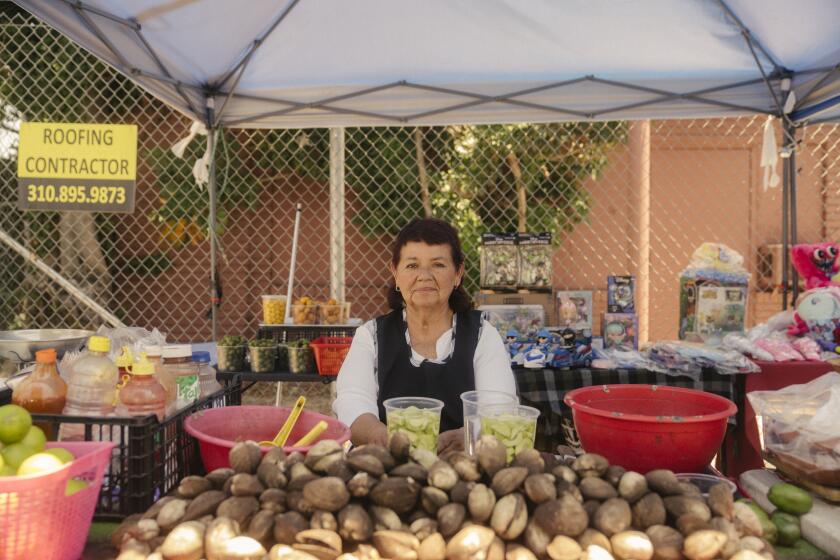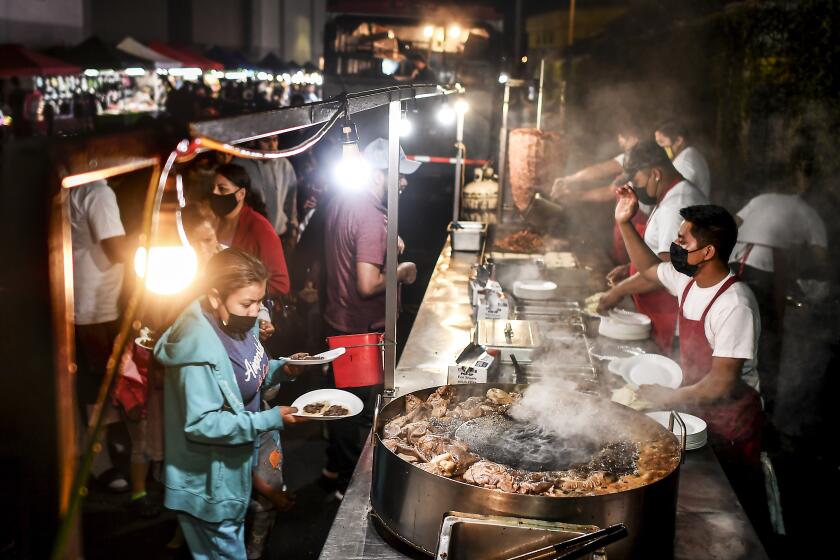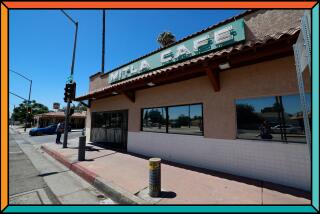
- Share via
- El Lagunero in Muscoy specializes in cabrito al pastor or split-roasted baby goat, a dish from north-central Mexico that’s rarely seen in the U.S.
- The community of Muscoy is 90% Latino and semirural, giving it a vibe, locals say, that is “just like Mexico.”
- Authorities sometimes crack down, but the unofficial taco row persists.
The first thing a visitor might notice upon approaching the taco stand Tacos de Cabrito y Machitos El Lagunero is the remains of a whole baby goat roasting on a spit over simmering mesquite.
The scent of the smoke upon the crisping meat is intoxicating. In a few moves, taquero Francisco Salinas whisks the goat off the spit and sets it sideways upon his flattop grill. Then he takes a butcher’s cleaver and begins hacking it down into chunks. Hours of roasting tenderizes the meat so much that Salinas can pull the bones out with barely any effort, the baby rib racks dismantling before our eyes as if by magic.
“It’s cooked all the way through,” Salinas said on a recent morning at his stand in Muscoy, holding a morsel of meat practically dripping off the bone.

This is cabrito al pastor, or spit-roasted kid, a north-central Mexican delicacy commonly associated with the city of Monterrey. It’s also become a part of the taquero scene in Texas. But in California, Monterrey-style cabrito is still a rarity.
Here in unincorporated San Bernardino County, Salinas is making cabrito al pastor in the style of his native Torreón, Coahuila, a metro region also known as La Laguna. It’s served as tacos, tortas, to-go, in crispy flautas or as a savory bowl of consomé with garbanzos and a variety of salsas.
The kids he uses are from a local farm and unweaned, meaning they only consume milk in their short lives of less than 45 days. “That is why the meat tastes so different,” Salinas said, compared to the more well-known birria de chivo.
In short, it is about as tender as taste buds could ever imagine, somehow fluffier than goat birria. Cabrito al pastor is an utterly unique bite.

On taco row
El Lagunero sits under white tarps in the back lot of an auto shop on State Street, part of a bubbling scene of taco and antojitos vendors that’s most active on weekends. The street food row took shape during the pandemic shutdowns and has remained popular among local eaters or drivers passing through, despite efforts to crack down from authorities.
Muscoy is more than 90% Latino, and many are Mexican immigrants with ranch homes in a semirural-designated agricultural area, meaning locals can raise and keep livestock. Deeper in the local culture in Muscoy, another layer of unlicensed vendors inside private residences offer raw goat milk spiked with alcohol, a little-known concoction from western Mexico that’s called a pajarete.
What is pajarete and is it safe? The drink from western Mexico involves fresh goat or cow milk, raw from the udder, mixed with cane alcohol and sugars.
Salinas and his partner Vanessa Sanchez initially worked facing the street. After repeated sweeps from inspectors, El Lagunero found a safer spot behind a gate, allowing Salinas to park his fire pit out in the open on weekend mornings.
Sometimes the pair surround the fire with bales of hay and a few decorative Mexican flags, so folks can take pictures next to it as if it’s a tourist attraction, like a portal to La Laguna.
“People love the cabrito because it’s consistent, and they love appreciating that it’s cooking right in front of them,” Sanchez said.
The pair are not afraid of engaging happily with taco trends either: Salinas and Sanchez offer their delicacy as birria ramen or quesabirria if any guest is so inclined. Mostly though, visitors sit with a steaming bowl of cabrito en consomé. The flavor is intensely satisfying and needs almost no garnishing.
“This past weekend there was a family from Washington. They came to California for some reason and put it on their plans to eat here,” Sanchez said. “We have people come from Mexicali, the San Fernando Valley, Bakersfield, San Francisco.”


In addition to the cabrito, El Lagunero offers another uncommon specialty: roast kid offal wrapped in chitterling membrane called machitos, which the taquero also prepares on stakes: soft baby goat heart, liver and kidney pieces roasted together into a symphony of organ-y textures and umami layers. The stand serves it in tacos as well.
The dishes’ roots go back centuries.
“This food was introduced by the criptojudíos [or secret Jews], who brought it to what was Tamaulipas, Coahuila and Monterrey,” Salinas said, in reference to the historical migration of Sephardic Jews who were escaping the Inquisition to north-central colonial Mexico. “They were shepherds, and they had these stakes to clean and cook the animals.”
Many brought their culinary traditions with them, and cabrito al pastor is said to have evolved from there.
Salinas got his start as a chef while serving in the Mexican military, cooking for officers and high-ranking officials for years. After emigrating, he began working in restaurants in Southern California, where he met his future partner Sanchez while they both worked at Rincon Taurino in Chino, a barbacoa restaurant. They became an item and moved to Muscoy. While still holding down other day jobs, their idea for Laguna-style cabrito from Salinas’ hometown took shape from there, opening in summer 2022.
The longtime market on Vermont Avenue has returned after a difficult year, but can its vendors find a way to survive?
Vendor troubles
In Muscoy, as in other parts of the state, the pandemic shutdowns opened the floodgates of entrepreneurial energy on the streets of Southern California, as instant layoffs sparked by the emergency public health orders forced thousands out of work. Many risked their last bits of cash to try a home cooking business in tacos or mariscos. Since 2020, State Street has become its own magnet, as Avenue 26 had done in Lincoln Heights, or the Salvadoran Corridor decades ago.
Technically, street vending and home kitchen businesses are legal in the state of California. But achieving licensed status is costly, time-consuming and actually draws more scrutiny and enforcement than being entirely off the books, multiple vendors said.
Health inspectors often patrol the street, issuing administrative citations or confiscating food; the presence of sheriff’s deputies gives folks the jitters. In response, vendors organize themselves online in group chats to alert one another if authorities are on their way, part of an ongoing tug-of-war over the public space.
“It’s terrible what the county does to the people,” Salinas said.
The office of Supervisor Joe Baca Jr., whose district oversees Muscoy, said in a statement that the county is seeking balance with neighbors’ needs and the vendors.
“We have heard our residents’ concerns and understand that the main issues they have are related to traffic and trash not being cleaned up,” Baca’s statement said. “We are committed to working with street vendors to create a harmonious environment for everyone.”
Several local vendors said in interviews they feel under siege from authorities. But officials defended their actions.
“The only time we seize food is when the health department deems the food unsafe,” said David Wert, public information officer for San Bernardino County.
The COVID-19 pandemic slowed down this Los Angeles night market, but it’s rebounding. You’ll find tacos, pizza and more.
Sanchez is a cheery presence at the stand handling drinks, salsas, garnishes and takeaway orders with her meticulously organized supplies. She said people in the area will always want to have a delicious taco or bowl of soup off the street, just like back home, especially when it’s made with effort and care. That’s what makes Muscoy special, she said.
“There will always be vendors here,” Sanchez said. “It’s a little piece of Mexico. In the climate, the culture, the food.”
El Lagunero, 2598 N. State St., Muscoy. Open 8 a.m. to 1 p.m. Saturday and Sunday or until sold out (usually by noon, sometimes as early as 10 a.m.).
More to Read
Eat your way across L.A.
Get our weekly Tasting Notes newsletter for reviews, news and more.
You may occasionally receive promotional content from the Los Angeles Times.















